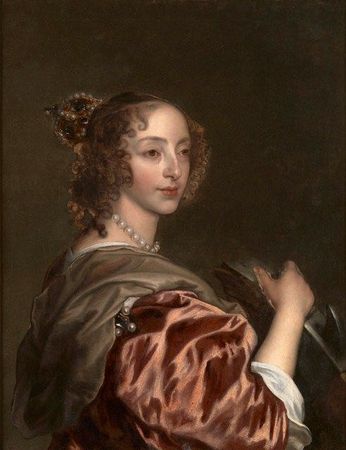A newly discovered painting of King Charles I's wife by Anthony Van Dyck on display for the first time to public
Attributed to Van Dyck, Queen Henrietta Maria (1609 -69), as St Catherine. © Philip Mould Ltd.
LONDON.- Queen Henrietta Maria (1609 -69), as St Catherine is believed to be Sir Anthony Van Dyck’s final portrait of the Queen, lost for centuries and only recently re-discovered and the public will now be able to see Henrietta Maria as she returns to Banqueting House on Whitehall, a place that would have been very familiar to the French wife of King Charles I.
Lent to Historic Royal Palaces the charity that looks after Banqueting House, by Philip Mould Ltd, and featured on last night’s BBC One's Fake or Fortune series, the small painting measuring only 76cm x 64cm is a half-length portrait of Henrietta Maria as St Catherine wearing the Imperial Crown. There is no early reference to this painting and up until now this image survived in a number of versions, none of them of high enough quality to be attributed with certainty to Van Dyck suggesting they were contemporary or later copies of a lost original by the artist.
Van Dyck was the most important Flemish painter of the 17th century after Rubens, whose works influenced the young artist. Van Dyck was an extremely successful portraitist and painter of religious and mythological pictures and was also an accomplished draughtsman and etcher. He settled at the English court in 1632, where his authoritative and flattering representations of Charles I, his family and his court, set a new standard for English portraiture.
He painted the King and his queen many times and the painting now on display at Banqueting House was recently discovered by Philip Mould and Bendor Grosvenor concealed within a larger painting of the queen that had been altered and over-painted in the 18th century. The decision was made to uncover the original painting which took almost 1,000 hours of conservation and required the use of over 500 scalpel blades to remove the later paint layers.
It is not clear as to why the portrait was concealed. There is visible under-drawing in the hair and around Henrietta Maria’s hands so it may have been because it was unfinished. However, at the time it would have been politically sensitive to show a queen in the guise of a Catholic saint – St Catherine of Alexandria. In the years preceding the Civil War, Henrietta Maria identified herself with St Catherine as she tried to convert Charles, and others, to the Catholic faith. This was to become one of the main reasons behind the growing rift between the King and his Parliament.
Henrietta Maria was born in Paris, the youngest daughter of Henry IV, King of France. She was fifteen when she crossed the Channel in 1625 to marry Charles I. After initial difficulties, the marriage proved close and lasting.
The Civil War saw the queen return to France in 1644, never to see her husband again as he was to be executed just outside the Banqueting House in 1649. News of Charles’ death took over a week to reach her. Henrietta Maria was devastated, retiring from court to the convent where she had lived as a young girl; she was never to really recover. However, in 1660, the widowed queen finally returned to England to see her son restored to the throne as King Charles II. She stayed at Whitehall Palace, the scene of her husband’s execution, “a very little plain old woman”, as Samuel Pepys records.
The painting will be on display until March 2013, for opening times visit hrp.org.uk

/https%3A%2F%2Fprofilepics.canalblog.com%2Fprofilepics%2F1%2F0%2F100183.jpg)
/https%3A%2F%2Fstorage.canalblog.com%2F03%2F02%2F119589%2F96711876_o.jpg)
/https%3A%2F%2Fstorage.canalblog.com%2F11%2F31%2F119589%2F94773502_o.jpg)
/https%3A%2F%2Fstorage.canalblog.com%2F20%2F83%2F119589%2F94772815_o.jpg)
/https%3A%2F%2Fstorage.canalblog.com%2F26%2F72%2F119589%2F75604929_o.jpg)
/https%3A%2F%2Fstorage.canalblog.com%2F59%2F60%2F119589%2F26458628_o.jpg)



/http%3A%2F%2Fstorage.canalblog.com%2F19%2F23%2F119589%2F128179837_o.jpg)
/http%3A%2F%2Fstorage.canalblog.com%2F10%2F81%2F119589%2F127170196_o.jpg)
/http%3A%2F%2Fstorage.canalblog.com%2F69%2F00%2F119589%2F125984989_o.jpg)
/http%3A%2F%2Fstorage.canalblog.com%2F31%2F08%2F119589%2F122135345_o.jpg)